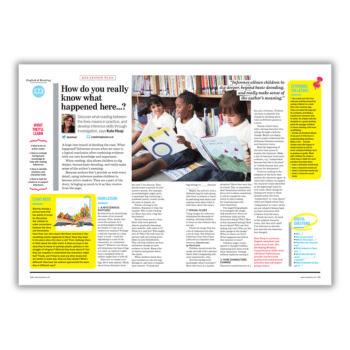Teaching inference – Take pupils on an investigative reading journey…

Take pupils on an investigative journey, and help them ferret out the clues they need to properly exercise their inference skills

- by Ryon Leyshon

I recently read a meta-analysis on teaching inference; specifically examining the impact of inference-focused instruction on reading comprehension (Elleman, 2017). It was both enlightening and concerning at the same time. Here’s why…
The headline takeaway, on the surface at least, was clear. Teaching children how to make inferences led to significantly improved reading comprehension in both skilled and less-skilled readers.
That’s great, right? So, why was I so concerned by this?
From my own background reading and personal experiences as the English lead in a primary school, I know that what one teacher considers to be an inference-focused instructional activity could be wildly different to another teacher’s views.
While one may be identifying meaning-rich words and phrases in their focus text to encourage children to consider, discuss and share ideas collaboratively, another could be teaching an entire ‘inference-focused’ reading lesson without a single word or text in sight!
Yes, you read that right; I have witnessed many teachers getting children to analyse pictures during reading lessons! They did so in the hope that pupils would develop a generalisable inferencing skill; in turn improving their reading comprehension.
My concerns rooted here; without a shared, research-informed understanding of what inference is, it would be easy to misinterpret and misuse this research.
So, what do we really mean when we talk about making ‘inferences’ during our reading?
Unfortunately, there are actually two main ideas, with slight differences, and this is where some ambiguity can creep in…
Text-based (cohesive) inferences
We use this conceptual understanding of the term ‘inference’ much less frequently in the classroom. However it’s still important for us all to be familiar.
It refers to the connections we must make between text-based information to build a coherent understanding of the text.
For example, we would make a simple text-based inference to connect the following two sentences: “Tom loved his new bike. He went straight outside to try it out.”
The text does not explicitly state that Tom rode the bike. But, it is the only logical inference to make based on the information we have stated within the text. A simple understanding of pronouns does most of the work here.
Text-based inferences can benefit from explicit teaching, especially when cohesive ties (words used to connect ideas across a text) are particularly difficult to match up to one another (say, for example, the nouns used to refer back to the same subject across many sentences are repeatedly varied – the dragon… the sinister beast… the mythical creature… the fire-breathing monster).
It is also worth noting that, as Zheng et al.’s (2023) recent meta-analysis in this area suggests, by developing children’s understanding of word order (syntax), sentence structure and cohesive ties as part of their grammar instruction, we can make significant improvements to children’s ability to successfully piece together text-based inferences. This then leads to improved reading comprehension.
Elaborative inferences
This is by far the most common conceptual understanding that we as educators refer to when using the term ‘inference’.
Elaborative inferences involve the reader drawing upon their existing knowledge base. They also build up a wider understanding of the world around them to make sense of ‘gaps’ in the text.
Here’s an example of a sentence in which the reader requires a very basic understanding of the world to piece together the events stated; “The coffee mug slipped out of her hands. Her favourite rug was surely ruined!”
Amongst various other elaborative inferences we could make (for example, the girl might be a bit careless or clumsy!), we will likely use our experiences and knowledge of the world to sensibly assume that the coffee spilled out of the mug causing a stain on the rug that would be difficult to get out.
Because elaborative inferences are so heavily based on, and constrained by, an individual’s existing knowledge/experiences, it doesn’t make sense for us to view this as a generalisable ‘skill’. Certainly not one that we should practise in isolation (and especially not with pictures). Rather, we should think of it as more of an accumulation of useful, relevant knowledge we are aiming to build up and refine. We need to use high-quality texts, over years of carefully-sequenced instruction.
Teaching inference
Making inferences then, both text-based and elaborative, sits at the heart of what reading is all about!
Piecing together the clues, speculating and revising our ideas as more clues are revealed, makes reading an active and enjoyable activity.
Wouldn’t it be great if we could spend more of our instructional time with children on these ‘meatier’, more enjoyable aspects of reading? It’s all the other little activities that bog us down.
Well, that is actually what the inference meta-analysis I mentioned earlier suggests…
Reading comprehension
The kinds of instructional activities included in the studies analysed weren’t revolutionary or overly complex; in fact, most of them would be fairly common in many classrooms.
So, why did they have such a significant positive impact on children’s reading comprehension?
I think the answer lies in the exclusion criteria of the meta-analysis. The researchers excluded all studies that devoted too much instructional time to developing literal comprehension and/or reading strategies. This left them with a wide range of studies that had one thing in common. They skipped the fluff, and went straight to the good stuff!
The studies included in the meta-analysis all focused on helping pupils to uncover, explore and make connections between the deeper, richer meaning hidden within the inferences of high-quality texts, avoiding extraneous activities that would take instructional time away from this goal.
It’s also interesting to note that the duration of the majority of the studies included in the meta-analysis were fairly short (less than 10 hours). This suggests that the gains in reading comprehension may be linked to an improved outlook on the reading process as a whole.
Some children may have realised what this whole ‘reading’ thing is all about due to immersion in meaning-rich activities.
Standards of coherence
It’s likely that the constant and largely uninterrupted focus on exploring inferences instilled the habits of good readers. Also that pupils’ ‘standards of coherence’ (the minimum amount of meaning they were willing to take from a text) had raised. This would put them in a stronger position when approaching future reading.
One last fascinating detail that emerged from the meta-analysis was that the least skilled readers – ones that would normally have difficulties with both literal and inferential comprehension – showed enormous gains across the included studies on their literal comprehension of the texts.
They didn’t need to be ‘drilled’ on mind-numbing retrieval activities (that could potentially ‘switched them off’ the text); they were able to build a more coherent literal understanding of the text through inference-focused instruction.
The message here is clear: inference is the key. But it is also vital that we truly understand the extent to which children’s inference-making abilities are dependent on the knowledge bases that we, as educators, carefully create.
Luckily for us teachers, this happens to be the fun stuff!
Inference-focused activities
- Inference question practice. Teachers provide questions that require pupils to generate an inference about the text.
- Text clue integration. Teachers show children how to use key clues within the text to construct and revise text understanding.
- Perspective taking. The emphasis is largely on children empathising with the characters to better consider their motives.
- Background knowledge strategy. Give children explicit guidance on how to choose relevant background knowledge to fill in gaps in the text.
- Text structure and organisation focus. Use graphic organisers to make the text structure clear and encourage relevant background knowledge use.
Ryon Leyshon is an experienced primary school teacher and English subject lead/coordinator.










